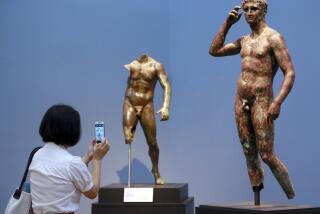Getty Museum Decides Its Achilles Head Is a Fake
- Share via
The J. Paul Getty Museum has concluded that a marble head of Achilles, once counted among the institution’s prime antiquities, is a fake.
Scholars originally attributed the massive head to Skopas, a major Greek sculptor and architect. The piece, dated 350-340 BC, was thought to have been part of a pediment depicting a scene from the Trojan War at the ancient site of Tegea, where Skopas built a temple to Athena Alea.
The Getty’s 1986 handbook calls the head “one of the few original Greek sculptures in Western European or American collections that can be placed within the context of a specific monument.”
But now the museum has revised its assessment, according to Lori Starr the museum’s press officer. “Following extensive research by our staff and outside scholars, we have concluded that the head is not a Greek original of the 4th Century BC,” Starr said. She declined to release specific details about the findings until the museum works out a settlement with the anonymous dealer who in 1979 sold the piece to the Getty.
The head has been under scrutiny for several years. It was removed from view last September, “when there was sufficient doubt to warrant a thorough investigation,” Starr said.
A marble stele identified as an archaic Attic grave relief has also been removed from the galleries for study, according to Starr. The authenticity of the stone slab has been under reconsideration for several years, she said. Upon completion of research on the stele, the museum will publish a report of its findings on both pieces.
Such revelations are embarrassments to museums, but Starr emphasized that objects at the Getty are constantly under study, particularly antiquities whose pedigrees are difficult to establish.
As the most visible American collector of antiquities, the Getty is under constant surveillance by scholars and less- credentialed critics who have often challenged the authenticity of the museum’s acquisitions and raised questions about legal ownership of cultural treasures that have been removed from their original context.
Italian authorities recently charged that a 5th-Century BC statue of Aphrodite, unveiled two weeks ago to an astonished art world, might have been smuggled out of Morgantina, Sicily, a decade ago. Subsequently, Italian magistrate Silvio Raffiotta has said that the statue was not stolen from Morgantina, but a final resolution of the investigation is pending.
The authenticity of the Aphrodite has not been questioned.
More to Read
The biggest entertainment stories
Get our big stories about Hollywood, film, television, music, arts, culture and more right in your inbox as soon as they publish.
You may occasionally receive promotional content from the Los Angeles Times.










